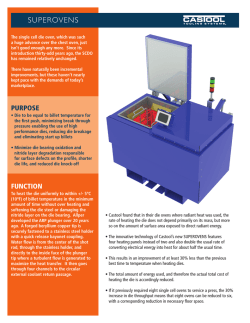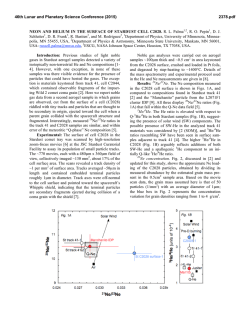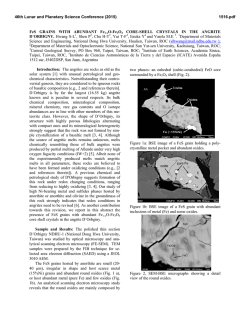
900005 - Sentinel Connector Systems
2. Using a screw driver turn eccentric axle (B) and toothed adjustment wheel (C) into new position. direction + for enlarging crimping force and reducing gap between crimping dies direction – for reducing crimping force and enlarging gap between crimping dies 3. Reinstall allen head screw (A) and tighten it. Fig.5. 90 32x18x28 Weight (g) 95 32x22x28 professional crimping tool for modular plugs for additional information contact Sentinel Loosen and remove allen head screw (A) using a 2.5 mm allen wrench. (Fig.5.) 2/6,4/6,6/6 plugs 1. 900217 After prolonged work period, tool crimping performance can change slightly due to final self-adjustment of the tools’ components. This handtool is equipped with eccentric axle which allows periodical adjustment of crimping force and tool recalibration to maintain correct crimp performance. shielded/unshielded 8/8 plugs ordering number: 900005 900216 Fig.4. 6. Tool regulation procedure LxWxH (mm) For crimping of IMPORTANT: Apply working force on the tool handles while unblocking. It will prevent hurting yourself and possible damages on the tool. Using small screwdriver or similar tool, push the ratchet relief (A), located inside the moving handle, ( Fig. 4.) in direction as shown to unblock the tool, and remove obstruction before continuing with the work. With this tool only microplugs of appropriate type have to be used. Crimping microplugs of unsuitable type may result with unsatisfactory characteristics of crimped connections and eventually with damaging of the tools and is to be strictly avoided. Dies set number This tool is intended for crimping of variety of modular plugs. For that purpose, individual dies sets are available for each different type of modular plug. Please note that the dies sets are ordered separately. 5. Unblocking the tool SOHDVH UHDG WKLV EURFKXUH FDUHIXOO\ EHIRUHXVLQJWKHWRROIRUWKHILUVWWLPH TM SENTINEL Connector Systems Inc. 1. Dies set selection 4. Maintenance and general remarks With dies sets only microplugs of appropriate type must be used. Crimping microplugs of unsuitable type may result with unsatisfactory characteristics of crimped connections and eventually with damaging of the tools and is to be strictly avoided. Prior to crimping, please check the alignment of the microplug to the dies set. Check the alignment (Fig.1) of contact crimp comb with contacts (A) and primary (C) and secondary (B) strain relief (if any). Fig.2. Crimping handtool 900005 with corresponding dies sets is intended to be used for crimping of modular plugs. Using this handtool for any other purpose, or for crimping of any other objects, can result in damaging the tool and the objects being crimped and prevention of its normal further functioning, for what manufacturer cannot be held responsible. Handtool is equipped with full cycle ratchet mechanism which with optimized leverage system within the tools make working with these tools easy and simple. In case of improper crimp, ratchet release mechanism allows you to easily open the handtool and remove obstruction before work is continued. Check unblocking procedure (item 5.) at the back of this brochure. 3. Terminating procedure Fig.1. *Note: Fig.1. represents unshielded 8P microplug and corresponding part of dies set. Choose dies sets correspondingly. Failing to do so will damage microplugs and possibly dies sets as well. After cable and microplug have been prepared, open handtool and insert microplug assembly into the opening of the dies set (as shown on Fig.3.) until plugs´ locking tab (A) snaps into place. Check if microplug is properly positioned in the die set and slowly close the tool completely until ratchet mechanism is released. Press locking tab (A) on the microplug and remove crimped connection from the die set. L Check at the back of this brochure for available dies sets. Tool itself also incorporates possibility of periodical adjustment of the crimping force and tool recalibration via eccentric axle to maintain correct crimp performance. Check tool regulation procedure (item 6.) at the back of this brochure. For removal of dust, moisture and other contaminants usage of clean brush or soft, lint-free cloth is recommended. Do not use agressive agents (thinner, alcohol,...) or hard objects that could damage the tool. Make sure that during the work bearing surfaces, shafts and pivot points are protected with thin coat of quality machine or motor oil. Do not oil excessively. 2. Dies set installation To install the dies set, unscrew dies set locking screw (B) (Fig.2.), then fully open handles of the handtool. Squeeze the dies set (A) slightly, position it as shown on the picture Fig.2. and insert it into the foreseen slot on the handtool. After making sure that it is correctly aligned with the handtool, tighten locking screw (B) to prevent dies set from falling out of its position and check if handtool opens and closes with no difficulties. Fig.3. L In case the tool becomes blocked for any reason, please follow unblocking procedure (item 5.) found on the back of this brochure. When the tool is not in use, store it in a closed position – with handles closed. That will keep other objects from becoming stuck between crimping dies and damaging them. Keep the tool in a dry and clean area.
© Copyright 2025








